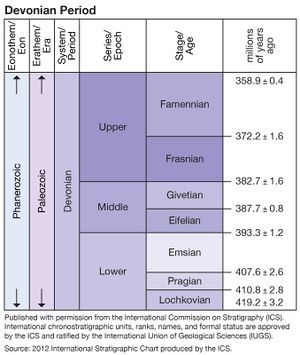Devonian

The Devonian was the fourth geological period of the Paleozoic era, extending from approximately 419.2 million to 358.9 million years ago. It is divided into Upper, Middle, and Lower epochs(Figure 1).[2] The name "Devonian" is derived from Devon, England, where rocks from this period were first actively studied. The period was first established by Adam Sedgwick and Roderick Murchison, British geologists, in 1839.[3]
The Devonian was a time of intense carbonate production in Earth's history. This resulted in peak coral reef growth and the greatest diversity of marine fauna, particularly shelled species such as brachiopods and bivalves, in the entire Paleozoic eon.[3] Lobe-finned fish developed in the Devonian, from which early tetrapods (four-legged animals) arose at the end of the Devonian (Figure 2). Vascular plants became fully established on land by the Middle Devonian (Figure 3). The Lower Devonian saw mostly small plants, with the first trees and forests appearing by the late Upper Devonian (Figure 4).[4] A massive extinction event marked the end of the Devonian.[3]
Most of the Earth's land area was part either the Gondwana (near the South Pole) or Euramerica (which was nearer to the equator) supercontinents. Euramerica was created through the collision of what the two smaller continents that would be North America and most Europe one day. This collision led to a massive mountain building event, forming the Appalachian Mountains. High sea level during this period resulted in large portions of both supercontinents being covered by large inland seas.[4] At the end of the Devonian, a glaciation event occurred, cooling the climate and lowering sea level. This glaciation is thought to have contributed to the mass extinction event that occurred at this time.[3]
-
Figure 2. Lobe-fish to early tetrapods.[5]
-
Figure 3. Fossilized Devonian plant.[6]
-
Figure 4. Artist rendition of the Devonian.[7]
For Further Reading
References
- ↑ International Commission on Stratigraphy."International Chronostratigraphic Chart v2012" Accessed Nov.16, 2018 [Online]. Available: https://www.britannica.com/science/Famennian-Stage/media/201153/133200
- ↑ 2.0 2.1 International Commission on Stratigraphy."International Chronostratigraphic Chart v2018" Accessed Nov.8, 2018 [Online]. Available: http://www.stratigraphy.org/index.php/ics-chart-timescale
- ↑ 3.0 3.1 3.2 3.3 Gradstein, F. M. "The Geologic Time Scale 2012". Volume 2. 1st ed. Amsterdam ; Boston: Elsevier, 2012.
- ↑ 4.0 4.1 University of California, Museum of Paleontology."The Devonian Period" Accessed Nov.16, 2018 [Online]. Available: http://http://www.ucmp.berkeley.edu/devonian/devonian.php
- ↑ WikiMedia Commons."File:Fishapods.jpg" Accessed Nov.16, 2018 [Online]. Available: https://commons.wikimedia.org/wiki/File:Fishapods.jpg
- ↑ WikiMedia Commons."File:Archaeopteris, Scotland, Upper Devonian period - Redpath Museum - McGill University - Montreal, Canada - DSC07986.jpg" Accessed Nov.16, 2018 [Online]. Available: https://commons.wikimedia.org/wiki/File:Archaeopteris,_Scotland,_Upper_Devonian_period_-_Redpath_Museum_-_McGill_University_-_Montreal,_Canada_-_DSC07986.jpg
- ↑ WikiMedia Commons."File:Devonianscene-green.jpg" Accessed Nov.16, 2018 [Online]. Available: https://en.wikipedia.org/wiki/Devonian#/media/File:Devonianscene-green.jpg


![Figure 2. Lobe-fish to early tetrapods.[5]](/wiki/images/thumb/d/db/Fishapods.jpg/440px-Fishapods.jpg)
![Figure 3. Fossilized Devonian plant.[6]](/wiki/images/thumb/8/8d/Archaeopteris%2C_Scotland%2C_Upper_Devonian_period_-_Redpath_Museum_-_McGill_University_-_Montreal%2C_Canada_-_DSC07986.jpg/165px-Archaeopteris%2C_Scotland%2C_Upper_Devonian_period_-_Redpath_Museum_-_McGill_University_-_Montreal%2C_Canada_-_DSC07986.jpg)
![Figure 4. Artist rendition of the Devonian.[7]](/wiki/images/thumb/b/ba/Devonianscene-green.jpg/322px-Devonianscene-green.jpg)